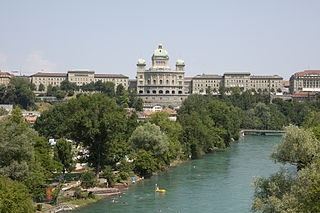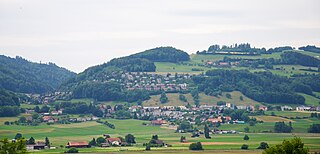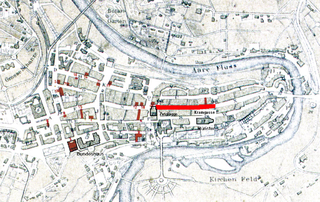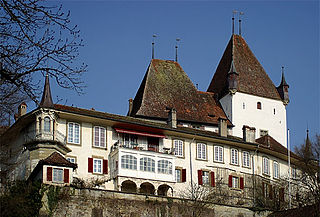
Bern, or Berne, is the de facto capital of Switzerland, referred to as the "federal city". With a population of about 133,000, Bern is the fifth-most populous city in Switzerland, behind Zürich, Geneva, Basel and Lausanne. The Bern agglomeration, which includes 36 municipalities, had a population of 406,900 in 2014. The metropolitan area had a population of 660,000 in 2000.

Friedrich Emil Welti known as Emil Welti was a Swiss politician, lawyer and judge. From 1856 to 1866, he was a member of the government of the canton of Aargau and, beginning in 1857, the Council of States. In 1867, Welti was elected to the Bundesrat as a representative of the liberal-radical faction.
The year 1782 in architecture involved some significant events.

The Federal Palace is a building in Bern housing the Swiss Federal Assembly (legislature) and the Federal Council (executive). It is the seat of the government of Switzerland and parliament of the country. The building is a listed symmetrical complex just over 300 metres (980 ft) long. It is considered one of the most important historic buildings in the country and listed in the Swiss Inventory of Cultural Assets of National Importance. It consists of three interconnected buildings in the southwest of Bern's old city. The two chambers of the Federal Assembly, the National Council and Council of States, meet in the parliament building on Bundesplatz.
Carl Ahasver von Sinner was a Bernese architect of the Louis XVI period.

Hofwil is a village in the canton of Bern, Switzerland, part of the municipality of Münchenbuchsee.

Kehrsatz is a municipality in the Bern-Mittelland administrative district in the canton of Bern in Switzerland.

The Kramgasse is one of the principal streets in the Old City of Bern, the medieval city centre of Bern, Switzerland. It was the center of urban life in Bern until the 19th century. Today, it is a popular shopping street. Its length, slight curve and long line of Baroque façades combine to produce Bern's most impressive streetscape.

The Junkerngasse is a street in the Old City of Bern, the medieval city center of Bern, Switzerland. It connects the tip of the Aar peninsula to the Münster.

Toffen Castle is a Baroque country estate in Toffen, Canton of Bern, Switzerland. It is a Swiss heritage site of national significance.

The Erlach family was a Bernese patrician family. They first became citizens of Bern around 1300. During the 17th and 18th centuries they were one of the leading families in Bern. For centuries the family served as senior military commanders in both Bern and in foreign armies. They were mayors of Bern and ruled over many other towns and cities in western Switzerland. Several family members received the upper nobility title "Reichsgraf".

The Béatrice-von-Wattenwyl-Haus is a town mansion on the Junkerngasse No. 59 in the Old City of Bern, only a few steps away from the Erlacherhof.

Oberhofen Castle is a castle in the municipality of Oberhofen of the Canton of Bern in Switzerland. It is a Swiss heritage site of national significance.

Rümligen Castle is a castle in the municipality of Rümligen of the Canton of Bern in Switzerland. It is a Swiss heritage site of national significance.

Landshut Castle is a castle in the municipality of Utzenstorf of the Canton of Bern in Switzerland. It is a Swiss heritage site of national significance.

Worb Castle is a castle in the municipality of Worb of the Canton of Bern in Switzerland. It is a Swiss heritage site of national significance.

Kehrsatz Castle is a castle in the municipality of Kehrsatz of the canton of Bern in Switzerland.

Lydia Welti Escher, was a Swiss patron of the arts. Lydia Escher was one of the richest women in Switzerland in the 19th century, a patron of the arts who most notably established the Gottfried Keller Foundation.

Ittigen Castle is a historical country house in Ittigen in the Canton of Bern in Switzerland.

Friedrich Emil Welti commonly known as Fritz Welti was a Swiss businessman and legal historian; one of the most influential figures in the Swiss insurance industry. His father was the Federal Councilor, Emil Welti and his first wife was Lydia Escher, a major patron of the arts.





















